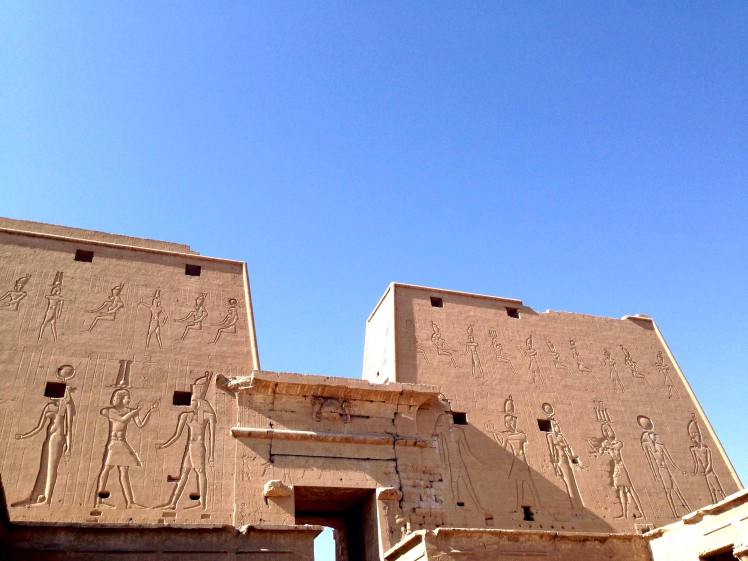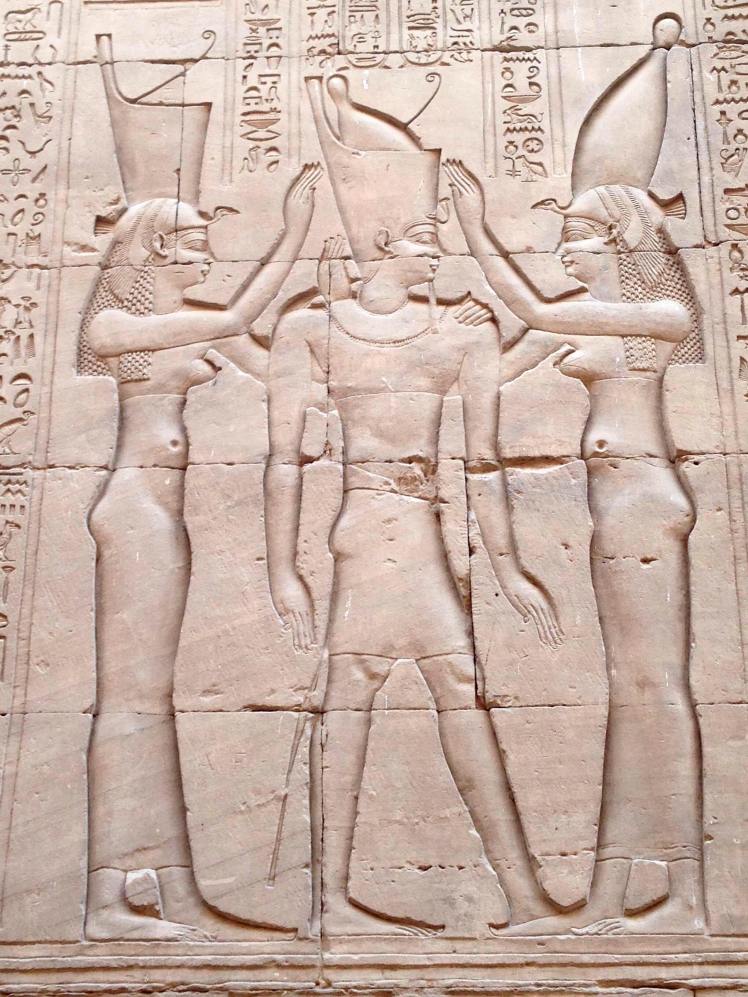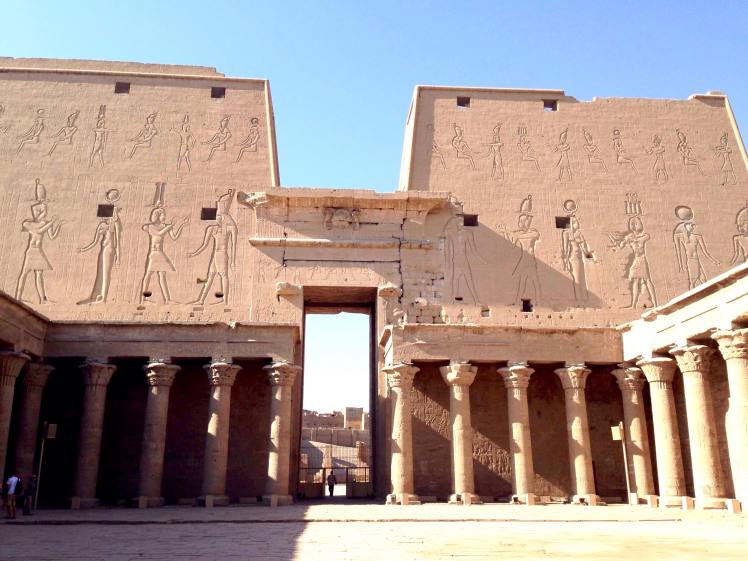Edfu temple, despite being smaller in size than Abu Simbel, Luxor and Karnak temples and perhaps less architecturally impressive to the eyes first glance was however one of my favourite stops along the River Nile.
This is due to it being one of the best preserved ancient temples in all of Egypt – a result of the desert sand maintaining its original glory from the time of its construction somewhere between 237 and 57 BC. We are fortunate that such natural protection was to be had because, with its roof intact, it not only provides us with an idea of the temples original form but it also retains the essence and energy of the Egyptians, making it one of the most atmospheric temples to be seen.

Edfu temple is otherwise known as the Temple of Horus and is believed to date back to the Ptolemaic times with the construction beginning during the reign of Ptolemy III (237 BC) and finishing during the reign of Ptolemy IV. The ancient hieroglyphics on the temples entrance reveal important information about the language, myth and religion during the Greco-Roman period in ancient Egypt.
In particular, the dedication to and worship of Horus who was the falcon-headed sky god, whose eyes were the sun and the moon. Later on he was assimilated into the myth of Isis and Osiris as their child. The wall decorations detail the scenes of the story of the divine birth of Horus the child in the presence of the goddess Hathor, the god Khenoum and other deities who were preoccupied with pregnancy and birth. The significance of Horus being raised by Isis and Hathor after Osiris’ murder by his brother Seth is evident in Horus’s avenging his father in a great battle at Edfu. Here Seth was exiled and Horus took the throne. It was believed that his father, Osiris, reigned through him from the underworld and thus all Pharaohs claimed to be the incarnation of Horus, ‘the living king’.
It is amazing to consider that the construction and inscriptions of this temple took around 180 years to complete – today everything happens with speed and efficiency whereas it is obvious that the motivation behind such a construction as this was spiritual devotion, a love, worship, and belief in an overriding power bigger than oneself, a religion that defined every waking moment of every individual in ancient Egypt. Suddenly, Edfu temple becomes even more impressive as a place of worship that unified the rich and the poor, the Pharaohs with the common people in a way unlike anything we can experience today.
Additionally, the inscriptions inside speak of a form of political propaganda that we are familiar with today – continually reinforcing for all to see the power and might of the Pharaoh and his royal bloodline. The inside walls are decorated with battle scenes, representing King Ptolemy VIII as defeating his enemies before the god Horus. I was amazed to see this repeated throughout the temple – it made me realise that history is made by the perspective of the influential and wealthy. I couldn’t help then but wonder how much of the past are we missing in our story books? What ever happened to the poor, common but no less important history of the common people?

Once I walked through the entrance and was confronted with one of the best preserved courtyards I have ever seen in Egypt I forgot all about my questions. I was amazed by the grandeur before my eyes. The open courtyard contains columns with floral capitals on three sides. According to historians, this court was open to the public and was known as the court of the offerings, the place where people could come and give their offering to the statue of Horus.

However, in 391 BC Theodosius I of Rome declared that non-Christian worship was illegal throughout the Roman Empire, meaning that Egyptians were no longer allowed to openly worship their gods or use the temple for religious purposes. During this period, many of the temples artifacts and sculptures were destroyed. Even today evidence of destruction is clear by the blackened ceiling within the hypostyle hall. It is believed that this was a result of a fire caused by the Christians attempting to eradicate all traces of paganism.
I would say that Edfu temple in its size and extravagant design is a clear indication of the wealth of Egypt history on offer. Its exceptional preserved state makes it a site beloved by many and a wonder to all tourists. A visit most definitely worth making!
Thanks for reading 🙂
X
I have always wanted to visit Egypt. I dont know why I feel attracted to that place, like some kind of Deja Vu. And here I keep on sipping my black coffee and reading about Egypt. Thank you for this descriptive post…
LikeLiked by 1 person
I’ve always wanted to go to Egypt! This looks like a great place to add to an itinerary!
LikeLiked by 1 person
Wow, the temple looks amazing. I love taking pictures of ancient architecture, hope I will be able to visit in the future.
LikeLiked by 1 person
Such a historical place to visit with so many things to explore
LikeLiked by 1 person
I’ve always wanted to go to Egypt. I’m been so obsessed with Egyptian history ever since I was a child. I loved how you wrote this post, especially the comment “it made me realise that history is made by the perspective of the influential and wealthy” (so true and very eye-opening).
LikeLiked by 1 person
Thank you! I love Egyptian history too! It was an amazing experience and if you get a chance you should go 🙂
LikeLike
Egyptian temples are all so mysterious and interesting: this one looks so full of details that you can comprehend only with a good guide. Thanks for being the first one.
LikeLiked by 1 person
This is a beautiful place. I have never been to Egypt before. It would be nice to visit one day.
LikeLiked by 1 person
Such an amazing post. Egypt is on my someday list. I love the detail in the pictures from the Edfu temple, it always amazes me that anything that old can still be standing in such good condition today. Very humbling.
LikeLiked by 1 person
Wow! That looks amazing! It really is so well preserved and gives a great light into what it was like back then, at least for the rich! haha
LikeLiked by 1 person
These pictures are so cool! Thank you for sharing Egypt!
LikeLike
Amazing! I’ve only heard of these temples in my World History class in college. I would love to visit that glorious Edfu temple in Egypt one day!
LikeLiked by 1 person
Thanks for bringing back those memories. Was in Egypt two years ago and did see the Edfu temple and as you say its was and is truly memorable.Wow!
LikeLiked by 1 person
This is really informative post on Edfu temple, Egypt. Only after reading this blog, I feel like visiting it.
LikeLiked by 1 person
Egypt is my dream place to visit. Love the temple architecture would love to visit there sometime. Thanks for the post
LikeLiked by 1 person
I would love to go there. The temple looks amazing. I love all of the carvings. I am just so impressed about how much they could decorate even back then. The sheer artistry amazes me.
LikeLiked by 1 person
woww what an old temple is!. Egypt of full of historical places and building and so does the the river Nile, but the age of this temple has amazed me a lot.
LikeLike